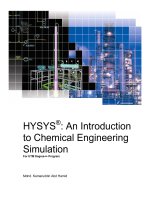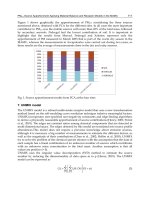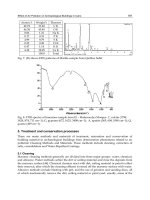An Introduction to Modeling and Simulation of Particulate Flows Part 11 pdf
Bạn đang xem bản rút gọn của tài liệu. Xem và tải ngay bản đầy đủ của tài liệu tại đây (80.88 KB, 5 trang )
05 book
2007/5/15
page 172
✐
✐
✐
✐
✐
✐
✐
✐
172 Bibliography
[195] van de Hulst, H. C. 1981. Light Scattering by Small Particles. Dover.
[196] Tuzun, U. and Walton, O. R. 1992. Micro-mechanical modelling of load dependent
friction in contacts of elastic spheres. Journal of Physics D: Applied Physics, Vol. 25,
A44–A52.
[197] van der Wal, A. C. and Becker, A. E. 1999. Atherosclerotic plaque rupture—
Pathologic basis of plaque stability and instability. Cardiovascular Research, Vol.
41, 334–344.
[198] Weidenschilling, S. J. and Cuzzi, J. N. 1993. Formation of planetesimals in the solar
nebula. In Protostars and Planets III. Levy, E. H. and Lunine, J. I., editors. University
of Arizona Press, 1031–1060.
[199] Weidenschilling, S. J., Spaute, D., Davis, D. R., Marzari, F., and Ohtsuki, K. 1997.
Accretional evolution of a planetesimal swarm. Icarus, Vol. 128, 429–455.
[200] Widom, B. 1966. Random sequential addition of hard spheres to a volume. Journal
of Chemical Physics, Vol. 44, 3888–3894.
[201] Wieland, M., Gray, J. M. N. T., and Hutter, K. 1999. Channelized free-surface flow of
cohesionless granular avalanches in a chute with shallow lateral curvature. Journal
of Fluid Mechanics, Vol. 392, 73–100.
[202] Williamson, S. D., Lam, Y., Younis, H. F., Huang, H., Patel, S., Kaazempur-Mofrad,
M. R., and Kamm, R. D. 2003. On the sensitivity of wall stresses in diseased arteries
to variable material properties. Journal of Biomechanical Engineering, Vol. 125,
147–155.
[203] Wriggers, P. 2002. Computational Contact Mechanics. John Wiley.
[204] Wurm, G., Blum, J., and Colwell, J. E. 2001. A new mechanism relevant to the
formation of planetesimals in the solar nebula. Icarus, Vol. 151, 318–321.
[205] Younis, H. F., Kaazempur-Mofrad, M. R., Chan, R., Chau,A. H., Hinton, D. P., Isasi,
A. G., Kim, L. A, and Kamm, R. D. 2004. Hemodynamics and wall mechanics in
human carotid bifurcation and its consequences for atherogensis: Investigation of
inter-individual variation. Biomechanics and Modeling in Mechanobiology, Vol. 3,
17–32.
[206] Zienkiewicz, O. C. 1984. Coupled problems and their numerical solution. In Numer-
ical Methods in Coupled Systems, Lewis, R. W., Bettes, P., and Hinton, E., editors.
Wiley, 35–58.
[207] Zienkiewicz, O. C. and Taylor R. L. 1991. The Finite Element Method. Vols. I and
II. McGraw-Hill.
[208] Zohdi, T. I. 2002. An adaptive-recursive staggering strategy for simulating multi-
field coupled processes in microheterogeneous solids. The International Journal of
Numerical Methods in Engineering, Vol. 53, 1511–1532.
05 book
2007/5/15
page 173
✐
✐
✐
✐
✐
✐
✐
✐
Bibliography 173
[209] Zohdi, T. I. 2003. Computational design of swarms. The International Journal of
Numerical Methods in Engineering, Vol. 57, 2205–2219.
[210] Zohdi, T. I. 2004. Modeling and simulation of a class of coupled thermo-chemo-
mechanical processes in multiphase solids. Computer Methods in Applied Mechanics
and Engineering, Vol. 193, 679–699.
[211] Zohdi, T. I. 2003. Genetic optimization of statistically uncertain microheterogeneous
solids. Philosophical Transactions of the Royal Society: Mathematical, Physical and
Engineering Sciences, Vol. 361, 1021–1043.
[212] Zohdi, T. I. 2004. Modeling and direct simulation of near-field granular flows. The
International Journal of Solids and Structures, Vol. 42, 539–564.
[213] Zohdi, T. I. 2004. A computational framework for agglomeration in thermo-
chemically reacting granular flows. Proceedings of the Royal Society,Vol. 460, 3421–
3445.
[214] Zohdi, T. I., Monteiro, P. J. M., and Lamour, V. 2002. Extraction of elastic moduli
from granular compacts. The International Journal of Fracture/Letters in Microme-
chanics, Vol. 115, L49–L54.
[215] Zohdi, T. I. 2003. Constrained inverse formulations in random material design. Com-
puter Methods in Applied Mechanics and Engineering, Vol. 192, 3179–3194.
[216] Zohdi, T. I. and Wriggers, P. 2005. Introduction to Computational Micromechanics.
Springer-Verlag.
[217] Zohdi, T. I. 2005. Charge-induced clustering in multifield granular flow. The Inter-
national Journal of Numerical Methods in Engineering, Vol. 62, 870–898.
[218] Zohdi, T. I. 2006. Computation of the coupled thermo-optical scattering properties
of random particulate systems. Computer Methods in Applied Mechanics and Engi-
neering, Vol. 195, 5813–5830.
[219] Zohdi, T. I. 2006. On the optical thickness of disordered particulate media. Mechanics
of Materials, Vol. 38, 969–981.
[220] Zohdi, T. I., Holzapfel, G. A., and Berger, S. A. 2004. A phenomenological model for
atherosclerotic plaque growth and rupture. The Journal of Theoretical Biology, Vol.
227, 437–443.
[221] Zohdi, T. I. 2005. A simple model for shear stress mediated lumen reduction in blood
vessels. Biomechanics and Modeling in Mechanobiology, Vol. 4, 57–61.
[222] Zohdi, T. I. and Szeri, A. J. 2005. Fatigue of kidney stones with heterogeneous
microstructure subjected to shock wave lithotripsy. Journal of Biomedical Materials
Research: Part B—Applied Biomaterials, Vol. 75B, 351–358.
[223] Zohdi, T. I and Kuypers, F. A. 2006. Modeling and rapid simulation of multiple red
blood cell light scattering Journal of the Royal Society Interface, Vol. 3, 823–831.
05 book
2007/5/15
page 174
✐
✐
✐
✐
✐
✐
✐
✐
174 Bibliography
[224] Zohdi, T. I., in press. Computation of strongly coupled multifield interaction in
particle-fluid systems. Computer Methods in Applied Mechanics and Engineering.
Available online at the journal website,
[225] Zohdi, T. I., submitted. Particle collision and adhesion under the influence of near-
fields. Preprint available upon request. Journal of Mechanics of Materials and Struc-
tures, />05 book
2007/5/15
page 175
✐
✐
✐
✐
✐
✐
✐
✐
Index
agglomeration, 55, 56, 134, 135
black-body, 61, 62, 85, 122
Boussinesq, 96
central force, 4, 5, 57
chemical mechanical planarization
(CMP), xv, 133
clustering, xvi, 55, 68–75, 105
CMP, see chemicalmechanicalplanariza-
tion.
conservative, 3, 4
contact, xv, xvi, 11, 12, 14, 15, 37, 58, 60,
71, 72
convexity, 39, 57, 58, 125
discretization, 14, 15, 22–24, 26, 63, 64,
66, 68, 83, 86, 123
electromagnetic, 104–108, 110, 112–114,
118, 120, 121, 128
emissivity, 61, 68, 85, 122
equation of state, 83, 96, 97, 142
FEM, see finite element method.
finite element method (FEM), 15
fixed-point, 26, 32, 61, 62, 64, 68, 70, 74,
75, 90, 98, 124
Fresnel, 110, 111, 113, 148, 154, 163
friction, 11, 17–19, 36, 37, 39, 77, 78
genetic, 40–43, 50, 51, 104, 107, 121,
125–128
granular media, xv
granular gas, xvi, 17, 72
Hessian, 4, 5, 42, 57
impact, 12–17, 19, 20, 26, 36, 39, 58–61,
64, 72–74, 79, 80, 85, 90, 91,
97
impulse, 7, 12, 18, 61
iterative scheme, 23, 25, 27, 62, 91, 123,
124
kinematic, 8
kinetic, 3, 7, 15, 16, 18, 33, 34, 40, 59,
60, 69, 71, 72, 85, 122
Maxwell, 103–107, 148, 152
momentum, xv, 6, 7, 12, 17–19, 60, 61,
72, 104, 122, 139–141, 162
Navier–Stokes, 81, 83, 86, 101, 143, 144
near-field, xv, xvi, 11, 12, 14–18, 26, 32–
34, 37, 39, 43, 47, 55, 58, 68,
69, 72, 81, 82, 86, 97–101, 133,
134
Newton, 3, 5, 7, 26, 44, 61, 64, 122, 139,
142–144
objective function, 39–42, 44, 50, 125–
128
particle, xv, 4, 6, 7, 11–18, 25, 31, 32, 37,
39, 47, 52, 55, 56, 58–61, 63,
68, 69, 71–75, 81, 101, 104–
106, 112, 114, 115, 119–130
potential, xvi, 4, 5, 44, 45, 55–57
Poynting, 108, 114, 120, 124, 153, 156,
157, 160
175
05 book
2007/5/15
page 176
✐
✐
✐
✐
✐
✐
✐
✐
176 Index
ray-tracing, 103–107, 120, 123, 124, 128,
147, 148, 153, 160, 162
reflection, 104, 111, 112, 120, 122, 162,
164
reflectivity, 104, 119
Reynolds, 61, 62, 83, 98, 144
scaling, 12, 52, 64, 95, 97, 114, 155
similarity, 8
spectral radius, 66, 67
stable, 4, 5, 22, 57, 115, 127
staggering, 25, 62–64, 66, 67, 81, 86, 90–
93, 102, 121, 123
Stefan–Boltzmann, 61, 62, 85, 91, 122
swarm, 47–54
transmission, 111, 114, 152
vectors, 1, 6, 9, 11, 50, 82, 110, 116, 129,
130
volume fraction, 31, 32, 68, 96, 104, 107,
115, 118–120, 126, 128–130,
154









